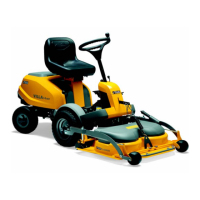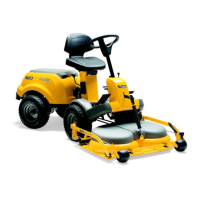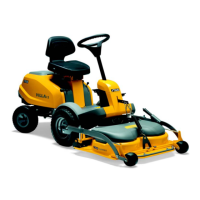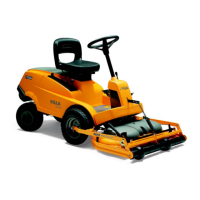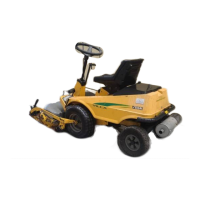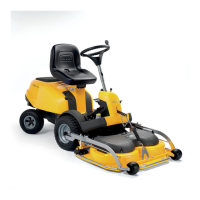Do you have a question about the Stiga VILLA 16 HST and is the answer not in the manual?
Explains symbols on the machine for safety and operational awareness.
Describes how figures and headings are referenced within the manual.
Describes the front-wheel drive and power transmission via drive belts.
Explains the rear-wheel steering system and its control mechanisms.
Details the electrical safety system that prevents dangerous operations.
Provides an overview of the primary controls for operating the machine.
How to operate the implement lifter between working and transport positions.
Explains the three positions of the combined service brake, clutch, and parking brake pedal.
Warning about not pressing the pedal while driving due to overheating risk.
Explains the function and operation of the parking brake inhibitor for locking the machine.
Details how the HST pedal controls forward/reverse drive and service braking.
Explains how to adjust the steering wheel height and a warning against adjusting during operation.
Describes the function of the throttle/choke lever for engine speed and cold starting.
Explains the ignition lock positions for starting, stopping, and operating headlights.
Describes the gear lever for selecting forward gears, neutral, or reverse.
Explains the lever for engaging and disengaging the power take-off for accessories.
Describes the control for electrical cutting height adjustment on HST models.
Explains the lever for disengaging the transmission to move the machine by hand.
Describes seat adjustment and its connection to the safety system.
Instructions for opening and closing the engine casing for access.
Lists essential safety checks for fuel, electrical, exhaust, and oil systems.
Procedure to verify the operation of the safety system before starting the engine.
Step-by-step guide for starting the engine, including fuel cock and PTO.
Instructions for starting cold and warm engines, including throttle control.
Advice on safe operation, especially on slopes, and avoiding tipping.
Procedure for safely stopping the engine and securing the machine.
Guidance on cleaning the machine to reduce fire risks from debris and leaks.
Ensures the machine is stationary, engine off, and brakes applied before maintenance.
Recommended air pressure for front and rear tyres.
Detailed steps for changing engine oil, including frequency and oil type.
Recommendation to replace the fuel filter annually and check for leaks.
Check that all belts are intact and undamaged after initial operation.
Procedure for checking and adjusting the steering system for play.
Guidance on battery charging, avoiding overcharging, and preventing short circuits.
Instructions for charging the battery using the engine's generator or a charger.
Procedure for safely removing and installing the battery, including cable connection order.
How to clean battery terminals coated with oxide.
Instructions for cleaning or replacing air filters based on operating hours and conditions.
Recommendation to replace the spark plug every 200 hours of operation.
Procedure for cleaning the engine's air intake to prevent overheating.
Details lubrication points and frequency for maintaining the machine.
Identifies fuses for specific faults and their locations.
Lists patent and design registration numbers for the machine.
Explains symbols on the machine for safety and operational awareness.
Describes how figures and headings are referenced within the manual.
Describes the front-wheel drive and power transmission via drive belts.
Explains the rear-wheel steering system and its control mechanisms.
Details the electrical safety system that prevents dangerous operations.
Provides an overview of the primary controls for operating the machine.
How to operate the implement lifter between working and transport positions.
Explains the three positions of the combined service brake, clutch, and parking brake pedal.
Warning about not pressing the pedal while driving due to overheating risk.
Explains the function and operation of the parking brake inhibitor for locking the machine.
Details how the HST pedal controls forward/reverse drive and service braking.
Explains how to adjust the steering wheel height and a warning against adjusting during operation.
Describes the function of the throttle/choke lever for engine speed and cold starting.
Explains the ignition lock positions for starting, stopping, and operating headlights.
Describes the gear lever for selecting forward gears, neutral, or reverse.
Explains the lever for engaging and disengaging the power take-off for accessories.
Describes the control for electrical cutting height adjustment on HST models.
Explains the lever for disengaging the transmission to move the machine by hand.
Describes seat adjustment and its connection to the safety system.
Instructions for opening and closing the engine casing for access.
Lists essential safety checks for fuel, electrical, exhaust, and oil systems.
Procedure to verify the operation of the safety system before starting the engine.
Step-by-step guide for starting the engine, including fuel cock and PTO.
Instructions for starting cold and warm engines, including throttle control.
Advice on safe operation, especially on slopes, and avoiding tipping.
Procedure for safely stopping the engine and securing the machine.
Guidance on cleaning the machine to reduce fire risks from debris and leaks.
Ensures the machine is stationary, engine off, and brakes applied before maintenance.
Recommended air pressure for front and rear tyres.
Detailed steps for changing engine oil, including frequency and oil type.
Recommendation to replace the fuel filter annually and check for leaks.
Check that all belts are intact and undamaged after initial operation.
Procedure for checking and adjusting the steering system for play.
Guidance on battery charging, avoiding overcharging, and preventing short circuits.
Instructions for charging the battery using the engine's generator or a charger.
Procedure for safely removing and installing the battery, including cable connection order.
How to clean battery terminals coated with oxide.
Instructions for cleaning or replacing air filters based on operating hours and conditions.
Recommendation to replace the spark plug every 200 hours of operation.
Procedure for cleaning the engine's air intake to prevent overheating.
Details lubrication points and frequency for maintaining the machine.
Identifies fuses for specific faults and their locations.
Lists patent and design registration numbers for the machine.
| Brand | Stiga |
|---|---|
| Model | VILLA 16 HST |
| Category | Lawn Mower |
| Language | English |
